Welcome to the fascinating world of blood pythons! These remarkable reptiles, known for their distinct size and striking presence, are a topic of intrigue for reptile enthusiasts and curious minds alike.
Blood pythons typically grow to 4-6 feet in length, with females generally larger than males. They can weigh over 30 pounds, with breeding females occasionally reaching over 7 feet and 30 pounds. These robust snakes are known for their stocky build and significant weight.
In this article, we delve into the key aspects of how big blood pythons get, exploring their growth stages from hatchlings to majestic adults, and comparing their size with other python species.
We’ll also shed light on the factors influencing their size, their specific care needs for optimal growth, and address some frequently asked questions.
Whether you’re considering a blood python as a pet or simply intrigued by these magnificent creatures, this comprehensive guide is your go-to resource for understanding the true scale of blood pythons.

Table of Contents
Blood Python Size Overview
When it comes to the fascinating world of reptiles, the blood python, a native of Southeast Asia, stands out due to its striking size and appearance. But just how big do blood pythons get? This question piques the curiosity of both reptile enthusiasts and casual observers alike.
Typically, an adult blood python ranges between 4 to 6 feet in length, with females usually on the larger end of this spectrum. It’s not just their length that’s remarkable; their weight is also noteworthy. These pythons can tip the scales at over 30 pounds, particularly in the case of breeding females who can grow over 7 feet long.
Interestingly, the size of these pythons can be influenced by various factors, including their environment, diet, and genetics. In captivity, where their diet is more controlled and consistent, they tend to grow faster and larger compared to their wild counterparts. It’s crucial for owners to monitor their diet closely as these pythons are prone to obesity due to their less active nature and efficient metabolism.
Their substantial size contributes to their allure but also demands a significant commitment in terms of care and habitat provision. The sheer physicality of blood pythons makes them a fascinating species to study and observe, but also a challenging pet to manage for those unprepared for their size and needs.
Size Comparison with Other Pythons
When placed alongside their python relatives, blood pythons present an interesting comparison in terms of size. While they may not be the longest snakes in the python family, their girth and weight set them apart. For instance, compared to the more commonly known ball python, blood pythons are a bit longer on average, but significantly heavier, weighing 3-5 times more.
This difference in build is due to their distinct body shape; blood pythons are considerably stockier, with a muscular build that gives them a powerful presence. In contrast, other python species like the ball python are more slender and less heavy-set. This stocky build of the blood python reflects their lifestyle as ambush predators, relying on their strength to capture prey.
Their unique size and build make them a standout species in the python world, but it also means that they require specialized care and handling. Prospective owners should be aware of these differences and prepare accordingly, as managing a heavy, muscular snake like a blood python is quite different from handling a slimmer, lighter species.
Growth and Development Stages
The growth journey of blood pythons is a fascinating process, segmented into distinct stages. Each stage brings its unique characteristics and requirements.
Hatchlings
The life of a blood python begins as a hatchling. Emerging from the egg, these tiny reptiles are typically around 12 inches in length. Despite their small size at birth, they exhibit a remarkable growth spurt during their early years.
Initially, they gain length more rapidly than weight, but as they approach the two-year mark, their weight starts to catch up, laying the foundation for their stocky adult build.
Juveniles
As they transition into the juvenile stage, blood pythons continue to grow steadily in both length and girth. This period is critical as it sets the stage for their adult size.
During these years, they start developing their characteristic muscular build, which is essential for their ambush hunting style. Proper nutrition and habitat are crucial during this phase to ensure healthy growth.
Adult Size
Reaching adulthood, blood pythons exhibit a noticeable difference in size between males and females. Males typically range from 4-6 feet, while females can grow up to 8 feet in certain cases. This is also the stage where they reach their full weight potential, often exceeding 30 pounds, especially in females.
Their growth rate slows down significantly at this stage, but their care and dietary needs continue to be a priority to maintain their health.
Factors Influencing Size
Several key factors play a role in determining the size of blood pythons. Understanding these can help in providing the right care and environment for these magnificent creatures.
- Genetics: Just like in humans, genetics play a pivotal role in the size a blood python can attain. Inherited traits from the parents can influence both the length and the girth of the python.
- Diet: The type and amount of food a blood python consumes significantly impact its growth and size. A diet that is rich in nutrients and well-balanced is essential for optimal growth.
- Environment: The conditions in which a blood python lives, including the temperature, humidity, and space available, can affect its growth. Blood pythons in captivity, where these conditions are more controlled, often grow larger and faster than their wild counterparts.
- Health and Care: The overall health and the care they receive, including regular veterinary check-ups and appropriate habitat maintenance, are crucial for their growth. Health issues or neglect can stunt their growth or lead to obesity.
- Activity Level: Although blood pythons are not known for being particularly active, their level of activity does have an impact on their physical development. Regular interaction and the opportunity to explore can contribute positively to their growth.
Care Requirements for Optimal Growth
Ensuring optimal growth for blood pythons involves a combination of proper diet, appropriate habitat, and regular health monitoring. Each of these elements plays a vital role in nurturing a healthy and well-sized python.
Diet and Feeding
Blood pythons have a hearty appetite and are generally good feeders. Their diet mainly consists of rodents like rats, which should be appropriately sized – not larger than the girth of the snake.
The feeding schedule varies with age; young pythons need more frequent feeding compared to adults. It’s crucial to strike a balance in feeding to prevent obesity, a common issue in captive blood pythons due to their low activity levels.
Monitoring their body condition and adjusting their diet as they grow is essential for their health.
Habitat and Enclosure
A proper enclosure is key to the growth and well-being of blood pythons. They require a horizontally spacious enclosure, as they are not adept climbers. The enclosure should be equipped with a temperature gradient, as blood pythons can’t regulate their body temperature independently.
A warm basking area and a cooler area should be provided, along with hiding spots on both sides. The size of the enclosure should grow with the snake, starting from a 10-gallon tub for hatchlings to larger dimensions for adults, typically 36 inches x 18 inches or more.
Health Monitoring and Veterinary Care
Regular health checks are imperative. Blood pythons are prone to certain health issues like respiratory infections and mites. A clean enclosure, correct humidity levels, and proper temperature settings are crucial to prevent these issues.
Regular veterinary visits can help identify and address any health concerns early on, ensuring the snake’s well-being and proper growth.
Choosing the Right Snake: Is a Blood Python Right for You?
Deciding if a blood python is the right pet for you requires careful consideration. These snakes, with their impressive size and specific care requirements, are not ideal for everyone, especially beginners in reptile care.
Blood pythons demand a significant commitment in terms of space, time, and resources. Their large size and feeding requirements mean they need a spacious enclosure and a consistent diet of appropriately sized prey.
Additionally, their temperament can be more challenging than other snakes, requiring patience and experience in handling. They can live up to 25 years or more, which is a long-term commitment.
If you’re new to snake ownership, starting with a more manageable and less demanding species might be advisable. However, for those with experience in reptile care and a keen interest in larger snakes, blood pythons offer a uniquely rewarding experience.
As always, thorough research and preparation are key to making an informed decision and ensuring the well-being of these fascinating reptiles.
Overview
You now understand that blood pythons, with their impressive size ranging from 4 to 6 feet and weighing over 30 pounds, are remarkable reptiles.
Their care, from diet to habitat, is crucial for their well-being. Whether you’re an aspiring owner or a reptile enthusiast, remember that these majestic creatures require commitment and understanding.
Embrace the journey of learning and caring for them; it’s a rewarding experience that deepens your connection with the natural world. Keep exploring and nurturing your interest in these fascinating snakes!
FAQ
What size tank does a blood python need?
The size of the tank for a blood python should correlate with the snake’s size and age. Hatchlings can start in a 10-gallon tank, but as they grow, the tank needs to be upsized. For an adult blood python, a tank that provides ample horizontal space is crucial, considering their non-climbing nature. A general guideline for adults is a tank measuring around 36 inches x 18 inches, but larger is always better to ensure they have enough space to move and explore comfortably.
Can two blood pythons live together?
It’s generally not recommended to house two blood pythons together. These snakes are solitary by nature and can become stressed or aggressive in the presence of another snake, especially in confined spaces. Additionally, there’s a risk of cannibalism and the spread of diseases. Individual housing is the best approach to ensure the health and well-being of each python.
How long can a blood python live?
Blood pythons have a relatively long lifespan, especially in captivity where their needs are well catered for. On average, they can live for about 25 years, but with excellent care, some individuals may even surpass 30 years. This longevity means owning a blood python is a long-term commitment.
How big do blood pythons need to be to breed?
Blood pythons typically reach sexual maturity based on size rather than age. Most blood pythons are ready to breed when they are around 3-4 years old. By this time, they should weigh at least 10-15 pounds. It’s essential to ensure they have completed most of their growth before breeding to avoid health complications. Breeding smaller or younger pythons can be risky for both the mother and the offspring.




0 Comments